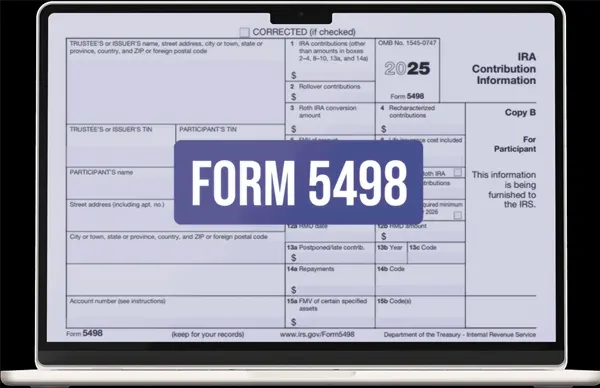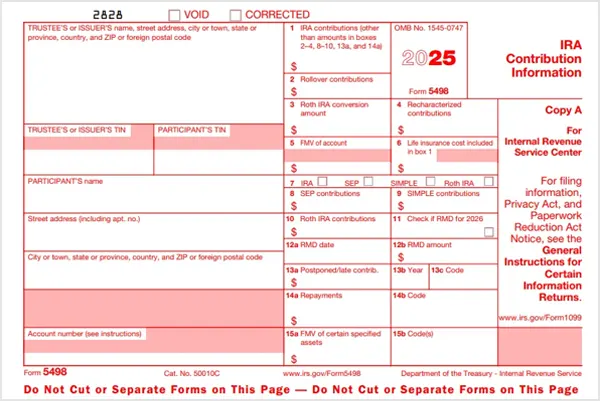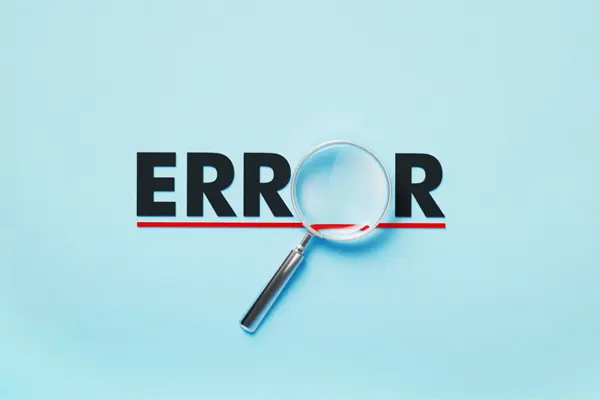What is the 5498 Tax Form? Reporting Information, Common Mistakes, and More
When you contribute to an Individual Retirement Account (IRA), you’ll get an IRS 5498 tax form. It is an informational document that keeps records of all your contributions to the IRA.
However, numerous people in the US don’t know about retirement plans and are intrigued by “what is Form 5498?”
Hence, to keep my readers familiarized with the tax form 5498, I’ve put together essential information in the write-up. Additionally, you will explore who receives this document, what is reported in it, and common mistakes to avoid when dealing with it.
What is the 5498 Tax Form?

The 5498 tax form is an informational document filed when you save for retirement with an Individual Retirement Arrangement (IRA). Taxpayers and the Internal Revenue Service (IRS) need this form to keep track of their contributions.
As an account holder, you don’t really need to file the tax form; you just keep it for your personal records. The financial institution that manages your IRA account is required to report all contributions during a tax year to both you and the IRS.
The contributions include:
- Traditional IRAs
- Roth IRAs
- SEP IRAs
- SIMPLE IRAs
Note: If you’re making a non-deductible traditional IRA, you need to file Form 8606.
Now, skim through the next section to understand what is reported on the Form 5498 taxes. It is critical to determine whether your contributions are filed accurately or not. Also, if you’re a small business owner using outsourced accounting or require services such as bookkeeping services you can see how proper record-keeping supports tax-form accuracy.
What is Reported on the 5498 Tax Form?

The IRS tax form 5498 reports contributions, rollovers, and conversions made to an IRA during the tax year. It helps the US government to monitor compliance with tax laws.
You can also check out the information mentioned below to calculate your tax liability and avoid penalties.
| Box Number | Description | What it Reports |
| Box 1 | IRA Contribution | Shows traditional and Roth IRA contributions you made for the tax year. |
| Box 2 | Rollover Contributions | Include amounts transferred into the IRA from another eligible retirement account, like a 401(k). |
| Box 3 | Roth IRA Conversions | Any funds converted from a traditional IRA or SIMPLE IRA to Roth IRAs or Roth SIMPLE IRAs. |
| Box 4 | Recharacterized Contributions | Amounts recharacterized or moved between different types of IRAs. |
| Box 5 | Fair Market Value (FMV) of Account | Total value of the IRA account at the end of the year. |
| Box 6 | Endowment Contracts | Amount allocable to the cost of life insurance. |
| Box 7 | IRA Type | It shows the type of IRA account (e.g., SEP, Roth, or Traditional). |
| Box 8 and 9 | SEP and SIMPLE Contributions | Include funds made in the current tax year. |
| Box 10 | Roth IRA Contribution | Shows contributions, including your income tax year in 2025 through April 15, 2026. |
| Box 11 | Required Minimum Distribution (RMD) Information | It informs the IRS, and the IRA owner must take a RMD for 2025. |
| Box 12a (optional) | RMD deadline | Reports the RMD deadline to an IRA owner. |
| Box 12b (optional) | RMD Amount | Reports the RMD amount to an IRA owner. |
| Box 13a | Late Rollover Contribution | Amount of any postponed contribution made in 2025 for a prior year. |
| Box 13b | Late Contribution Year | Shows the year in which the postponed contribution was credited. |
| Box 13c | Applicable Code | Reports the code reflecting the reason for the late contribution. |
| Box 14a | Repayment of a Contribution | Amount related to a qualified disaster, reservist, birth or adoption, domestic abuse victim, or emergency personal expense. |
| Box 14b | Repayment Code | Shows the applicable repayment code for box 14a (e.g., QR, DD, or BA). |
| Box 15a | FMV of the Investments | Shows the FMV (fair market value) of the investments, like stock or real estate, in the IRA. |
| Box 15b | Code for Investment Types | Include codes for different types of investments (A- stock, B- short or long-term debt, etc.). |
Tip: Always cross-check the numbers on your 5498 tax form with your own personal records of contributions and rollovers. If you handle more advanced services like year-end accounts services you’ll appreciate the importance of matching institutional reports with your internal bookkeeping.
Also Read: What is an Ad Valorem Tax? Definition, Reporting, and How It Is Assessed
What is a Form 5498-SA?
Form 5498-SA is another IRS document that reports contributions to a health savings account. The contributions include a Health Savings Account (HSA), an Archer Medical Savings Account (MSA), or a Medicare Advantage MSA.
Like tax form 5498, it is filed by the financial institution to the IRS, and a copy is sent to you for informational purposes only. Therefore, you should double-check that the form is correct and save it with your tax records.
However, it is important to note that the Form 5498-SA is not submitted with your tax return, unlike the Medicare Tax.
Now, explore the information included in this tax form. You should also ensure that your record-keeping of health-savings contributions is as organised as your cash-flow management service setup.
- Contributions made for the prior tax year
- Rollover contributions
- The Fair Market Value (FMV) of the HSA or MSA account
- Type of account
After acquiring information on “what is Form 5498 and 5498-SA,” you are all set to understand who receives the Form 5498. So dig deeper into the following section.
Who Receives the Form 5498?
You receive a 5498 tax form if you contributed to an Individual Retirement Account (IRA) during a tax year. The IRA trustee or custodian issues this form usually around May 31 (after the April tax filing deadline) because it allows you to make IRA contributions for the previous tax year until tax day.
Furthermore, if you contributed to more types of IRA accounts, you get multiple tax forms for each payment. For example, if you have a Traditional IRA account in one bank and a Roth IRA account in another bank, it’s apparent that you will receive separate forms for each account. If you’re running a new business and use an accounting service for startups you’ll want to integrate your retirement-plan reporting into your overall business accounting workflow, helping you avoid surprises with forms such as the 5498.
Also Read: Crypto Tax Calculator 2025: Benefits, Factors, and How a Cryptocurrency Tax Calculator Works?
What Should You Do with the Tax Form 5498?
You should remember not to file the 5498 tax form and keep it safe for accuracy, records, as a guide for tax return, and to track your basis for a Roth IRA.
Let’s take a look at the following pointers to estimate what to do with the tax form 5498.
Do Not File It
The tax form is for informational purposes only, so you’re not required to file it. Your financial institution handles the filing status with the IRS on its own.
Review for Accuracy
You should carefully check all your contribution lists in the 5498 tax form to match your personal records. If you discover any discrepancy in it, immediately contact your IRA provider to correct the mistake.
Keep It for Your Records
Moreover, you should keep the form copy with other tax documents safely. It helps you to verify your contributions in case of an IRS inquiry or audit.
Use it to Guide Your Tax Return
While you do not file the form itself, you will use the information when preparing your tax return, especially for a traditional IRA deduction. It confirms the contribution amount your provider reported to the IRS and saves you from encountering Tax Topic 152.
Track Your Basis for a Roth IRA
If you have a Roth IRA account, you can use Tax Form 5498 to track your contributions over the years. This information is crucial if you need to take an early withdrawal because it helps you calculate the taxable portion of the distribution. If you’re leveraging full-service financial solutions (such as combining payroll, bookkeeping, and startup accounting) then connecting your retirement-form tracking with your back-office services like payroll accounting services can ensure your holistic financial compliance.
What are the Mistakes You Should Avoid in the 5498 Tax Form?

“Make sure that you do not file the 5498 Tax Form or Form 5498-SA with your tax return.” In order to avoid common mistakes when dealing with the IRS form, you should read the following reminders.
Here are the errors that the trustee should not make in filing the tax form 5498:
- Issuing duplicate forms can lead to penalties.
- Incorrect personal information
- Reporting your contributions for the wrong year.
- Failing to report a correct conversion from a Traditional IRA to a Roth IRA.
- Reporting an incorrect Fair Market Value (FMV).
- Missing RMD information, resulting in a 50% excise tax on the under-distributed amount.
- Your custodian report transfers as rollovers.
Also Read: What is Receivables Financing? Why is Accounts Receivable Financing Important for Businesses?
The Bottom Line
The above-mentioned information helps you to understand what is tax form 5498. It is just an information document that keeps records of all contributions you made to the Individual Retirement Account (IRA) for retirement savings.
If you contributed to a Traditional IRA or a Roth IRA account, you should hire trustworthy and reliable tax professionals to file it on your behalf with the IRS. Additionally, you can utilize their expertise in filing other forms like the K1 tax form accurately and effortlessly.
Frequently Asked Questions
Ans: No, you are not required to report anything from the tax form 5498 because it is for informational purposes only.
Ans: The Form 5498 reports all contributions and activity of your IRA to both you and the IRS. It helps you track compliance with tax laws.
Ans: Retirement accounts that use Form 5498 include:
- Traditional IRAs
- Roth IRAs
- Simplified Employee Pension (SEP) IRAs
- Simple IRAs
Ans: If you have an IRA account but didn’t make any contributions, you will not get a Form 5498 for that tax year. A delay in USPS shipping or outdated mailing information can also be reasons for not receiving the form.
Ans: You should keep Form 5498 for at least seven years after all distributions are taken or after the account is completely emptied.
Sources: